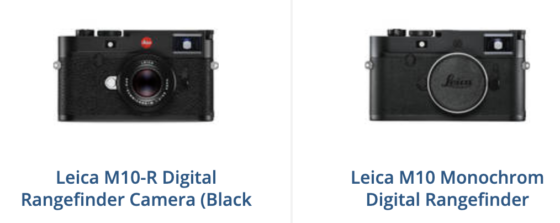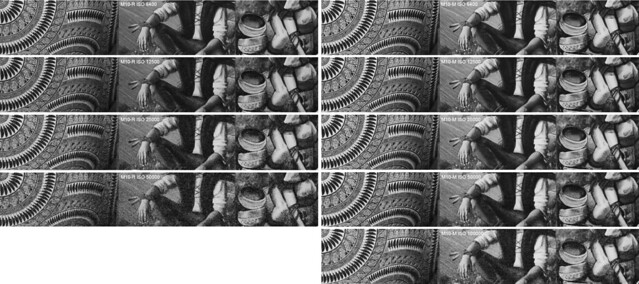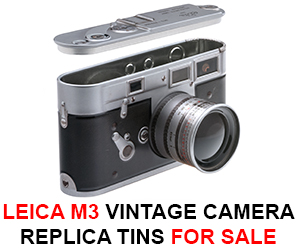
Leica M10-R vs Leica M10 Monochrom high-ISO acuity and noise side-by-side comparison
By Onasj (see previous articles by Onansj)
I obtained a customer-release—not pre-release/beta—M10-R and compared it side-by-side with the M10 Monochrom (hereafter referred to as the M10-M) on a test scene at high ISO values. The firmware version for both was the latest firmware currently available to the public: 10.20.27.20 for the M10-R (upgraded from the initial released 10.20.23.49 firmware that was pre-installed in the new camera), and 2.12.8.0 for the M10-M.
Methodology: all shots were taken on a tripod with a 2-second delay to minimize vibration. The same Leica 50 APO lens was used for all tests. The aperture was set to f/5.6 for all tests, at which the resolving power of the 50 APO is about as high as possible among commercially available 35-mm format lenses. The ISO value and shutter speeds were as follows:
ISO 6400, 1/60 s
ISO 12500, 1/125 s
ISO 25000, 1/250 s
ISO 50000, 1/500 s
ISO 100000 (M10-M only), 1/1000 s
To the best of my ability, the M10-R and the M10-M were treated equally. The test shots were taken in one sitting, with the same tripod position 2.2 m from the target, and under the same lighting. The images were focused by rangefinder and confirmed by live view for each camera. The subject distance (2.2 m) was farther from the test scene than my earlier M10-R tests (1.3 m) because I anticipated that the M10-M might have no trouble resolving all the details of the scene from 1.3 m, even at absurdly high ISOs.
Here is the uncropped test scene:
To keep the test as pure as possible, all the test shots were taken as DNG files, then transferred and opened in Adobe Photoshop 2020 with Camera Raw 12.3 (which has native M10-R support) with no corrections or adjustments to the default image settings, other than clicking “B&W” to convert the M10-R images to monochrome. Therefore, this test does not really answer the question of how the performance between the cameras compares if one were to bring the full power of modern post-processing, noise removal, AI-driven scaling and sharpening, etc. to bear on the images. It also does not exploit the important ability of adjusting the levels of different colors when converting color files to monochrome files—arguably the largest advantage of using the M10-R to generate monochrome photos instead of the M10-M. Instead, the purpose of this test is to compare the acuity and noise level of the two cameras at ISO 6400 to ISO 50000.
Overall, both cameras take remarkably good monochrome photos, even at ISO levels such as 12500 that would previously be considered out-of-reach. Here are 100% crops from a small portion of the center region of both cameras (M10-R on the left, M10-M on the right). I would have no hesitation using ISO 12500 monochrome images from either camera for virtually any application. But of course there are substantial performance differences.
Finding #1: The M10-M captures higher acuity levels than the M10-R across the ISO range tested (6400 to 50000).
As expected, given the lack of a Bayer color filter array (CFA) and no need to de-mosaic the red-, green-, or blue-filtered pixels, the M10-M offers significantly higher acuity than the M10-R. To my eye, the advantage persists even if you give the M10-R an advantage of one or two stops: compare the sharpness of the fine features of the scene as captured by the M10-M at ISO 25000 vs. the M10-R at ISO 6400, or the M10-R at ISO 25000 to the M10-M at ISO 100000—a remarkable testament to the M10-M’s ability to capture a scene down to the smallest details, even zooming in to 100%. Notice also that at the same ISO level, aperture, and shutter speed (chosen by each camera’s auto-shutter speed setting to be the same at all ISO levels!), the M10-M images are only modestly brighter than the M10-R; I was surprised that the Bayer CFA didn’t dim the M10-R images more strongly. Perhaps the M10-R firmware partially compensates for the loss of light due to the Bayer CFA.
Finding #2: The M10-M offers about a 1- to 2-stop advantage in high-ISO noise levels over the M10-R.
Compare the M10-M at ISO 50000 to the M10-R at ISO 12500, or the M10-M at ISO 25000 to the M10-R at ISO 6400. The M10-M continues to blow me away with its high-ISO performance. Indeed, Bill Claff’s measurements at https://photonstophotos.net/Charts/PDR.htm rank the M10-M’s high ISO performance as fourth among all cameras tested to date, behind the Phase One IQ4, the Phase One IQ3, and the Fuji GFX-100—three current or recent top-of-the-line medium format cameras.
Overall, Leica has created in the M10-M and the M10-R two current-generation sister cameras with outstanding overall performance. If acuity or high-ISO performance is more important than color for your particular application, than the M10-M outperforms the M10-R and is among the very best cameras to my knowledge, even joining some medium-format monsters. And if color is needed, either in the final image or to enable creative conversion to black and white images that allows easy sky darkening, face lightening, etc. during post-processing, the M10-R remains an option worthy of its current flagship status among Leica M cameras.
Leica M10 vs. Leica M10P vs. Leica M10M vs. Leica M10R specifications comparison

















